2017 Business Model Analysis: Innovation and Sustainability
VerifiedAdded on 2020/03/13
|7
|2088
|91
Report
AI Summary
This report provides an in-depth analysis of business models, focusing on innovation and sustainable business development. It explores the core concepts of business models, their evolution, and the importance of adapting to changes in technology and market demands. The report discusses business model archetypes, the impact of big data on business strategies, and the role of data analytics in understanding customer behavior and preferences. A significant portion of the report is dedicated to a case study of Starbucks, illustrating how the company utilizes big data to determine optimal locations for new stores, customize offerings, and enhance employee relations. The report emphasizes that business models are dynamic and must evolve to remain competitive, highlighting the need for companies to continuously upgrade their processes and leverage technology for efficiency and customer satisfaction. References to supporting literature are included to validate the discussed concepts.
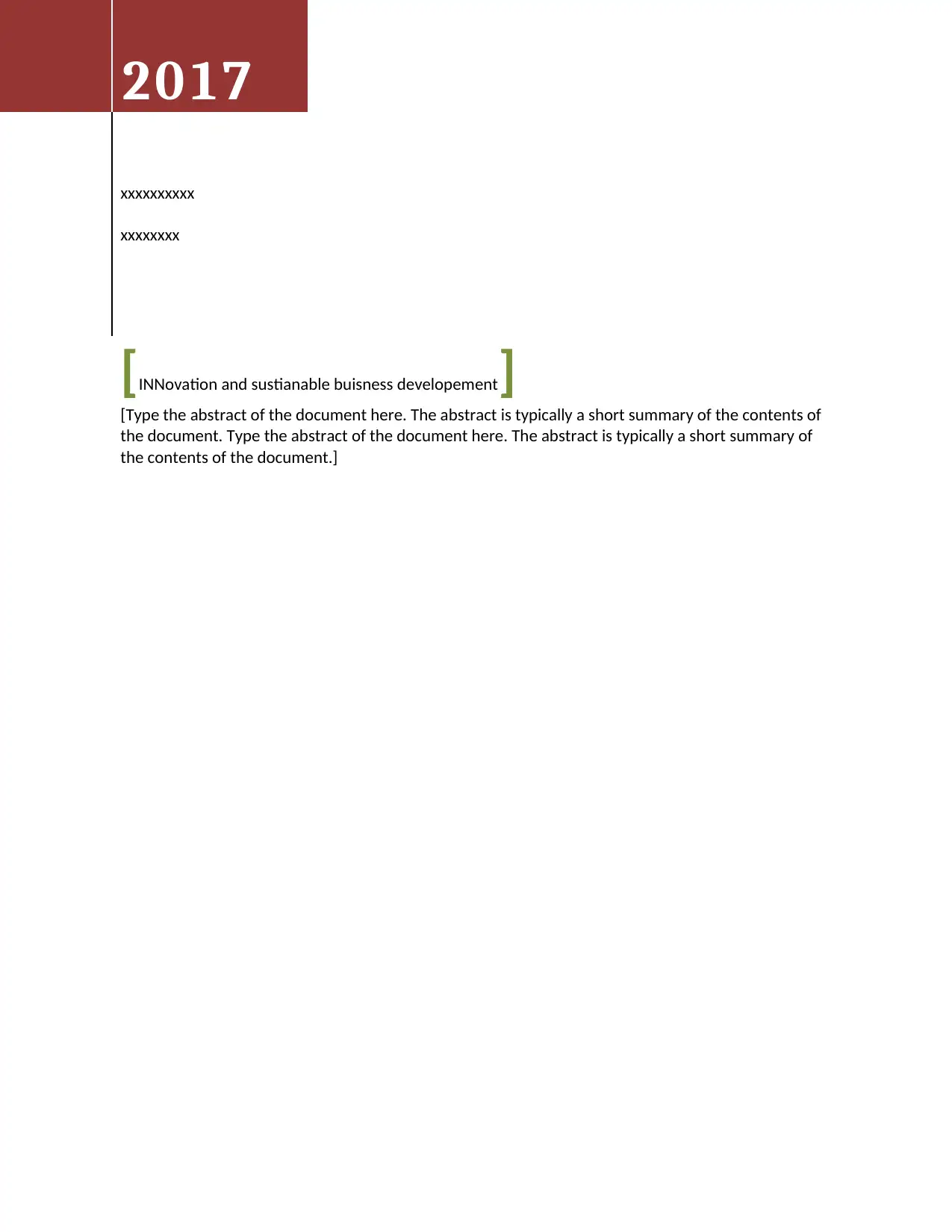
[INNovation and sustianable buisness developement]
[Type the abstract of the document here. The abstract is typically a short summary of the contents of
the document. Type the abstract of the document here. The abstract is typically a short summary of
the contents of the document.]
2017
xxxxxxxxxx
xxxxxxxx
[Type the abstract of the document here. The abstract is typically a short summary of the contents of
the document. Type the abstract of the document here. The abstract is typically a short summary of
the contents of the document.]
2017
xxxxxxxxxx
xxxxxxxx
Paraphrase This Document
Need a fresh take? Get an instant paraphrase of this document with our AI Paraphraser
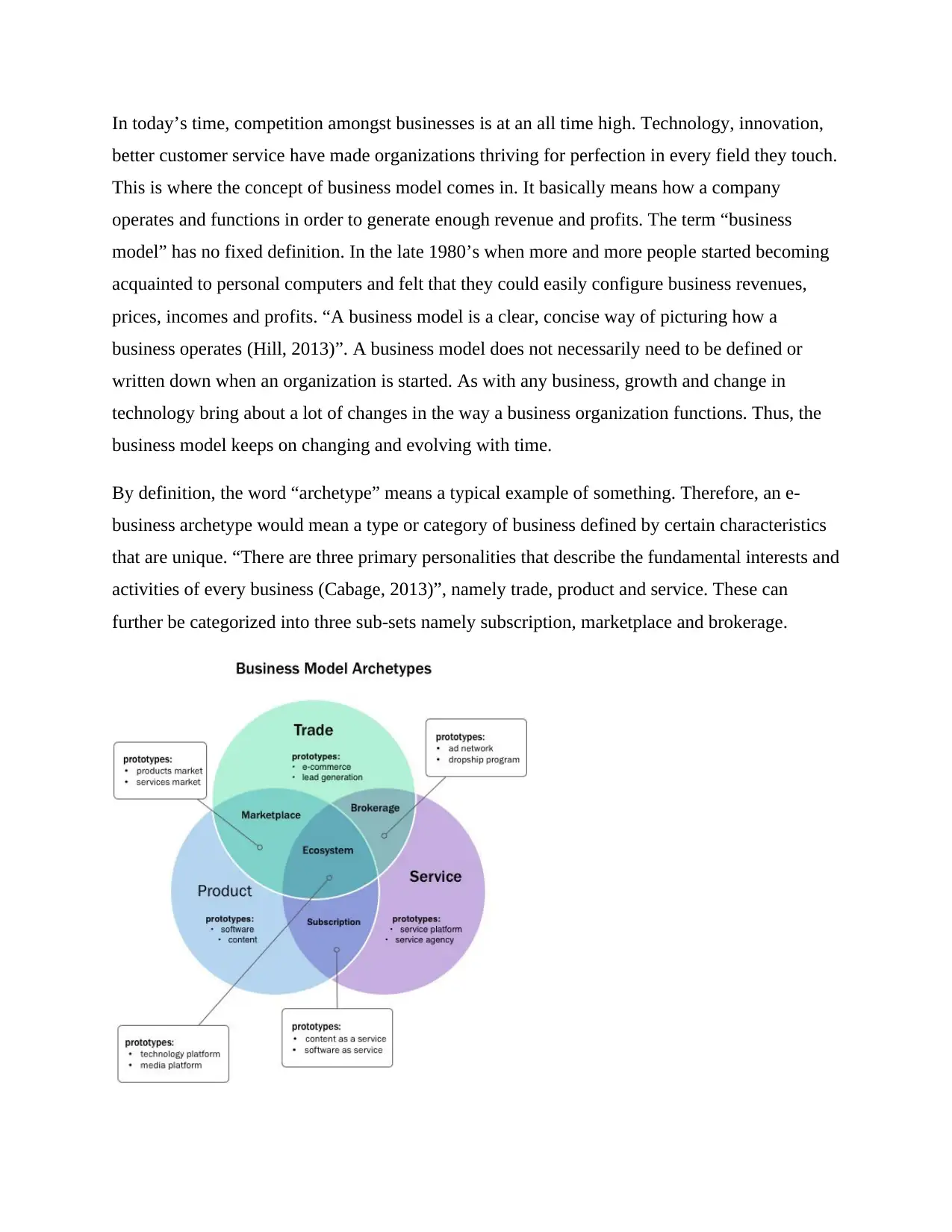
In today’s time, competition amongst businesses is at an all time high. Technology, innovation,
better customer service have made organizations thriving for perfection in every field they touch.
This is where the concept of business model comes in. It basically means how a company
operates and functions in order to generate enough revenue and profits. The term “business
model” has no fixed definition. In the late 1980’s when more and more people started becoming
acquainted to personal computers and felt that they could easily configure business revenues,
prices, incomes and profits. “A business model is a clear, concise way of picturing how a
business operates (Hill, 2013)”. A business model does not necessarily need to be defined or
written down when an organization is started. As with any business, growth and change in
technology bring about a lot of changes in the way a business organization functions. Thus, the
business model keeps on changing and evolving with time.
By definition, the word “archetype” means a typical example of something. Therefore, an e-
business archetype would mean a type or category of business defined by certain characteristics
that are unique. “There are three primary personalities that describe the fundamental interests and
activities of every business (Cabage, 2013)”, namely trade, product and service. These can
further be categorized into three sub-sets namely subscription, marketplace and brokerage.
better customer service have made organizations thriving for perfection in every field they touch.
This is where the concept of business model comes in. It basically means how a company
operates and functions in order to generate enough revenue and profits. The term “business
model” has no fixed definition. In the late 1980’s when more and more people started becoming
acquainted to personal computers and felt that they could easily configure business revenues,
prices, incomes and profits. “A business model is a clear, concise way of picturing how a
business operates (Hill, 2013)”. A business model does not necessarily need to be defined or
written down when an organization is started. As with any business, growth and change in
technology bring about a lot of changes in the way a business organization functions. Thus, the
business model keeps on changing and evolving with time.
By definition, the word “archetype” means a typical example of something. Therefore, an e-
business archetype would mean a type or category of business defined by certain characteristics
that are unique. “There are three primary personalities that describe the fundamental interests and
activities of every business (Cabage, 2013)”, namely trade, product and service. These can
further be categorized into three sub-sets namely subscription, marketplace and brokerage.
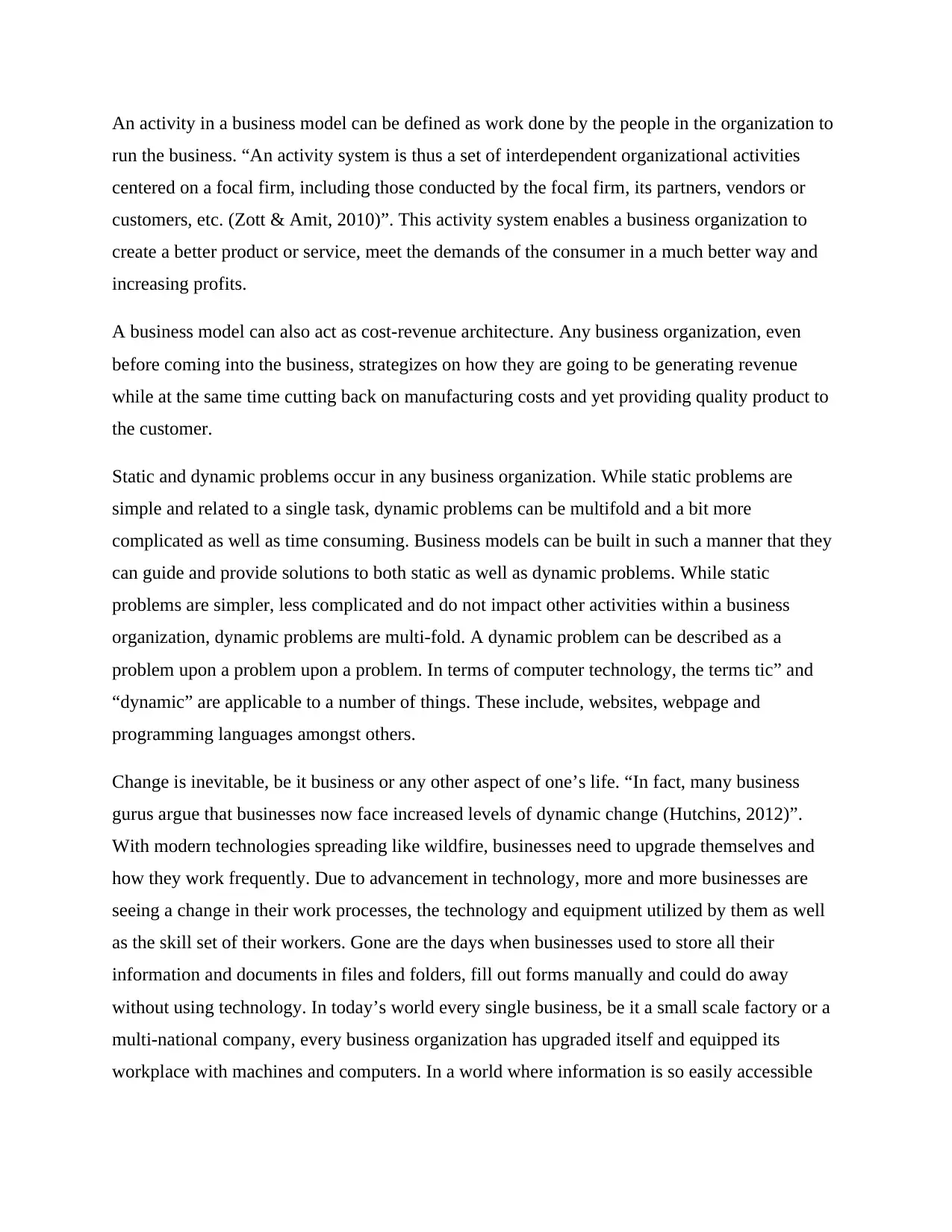
An activity in a business model can be defined as work done by the people in the organization to
run the business. “An activity system is thus a set of interdependent organizational activities
centered on a focal firm, including those conducted by the focal firm, its partners, vendors or
customers, etc. (Zott & Amit, 2010)”. This activity system enables a business organization to
create a better product or service, meet the demands of the consumer in a much better way and
increasing profits.
A business model can also act as cost-revenue architecture. Any business organization, even
before coming into the business, strategizes on how they are going to be generating revenue
while at the same time cutting back on manufacturing costs and yet providing quality product to
the customer.
Static and dynamic problems occur in any business organization. While static problems are
simple and related to a single task, dynamic problems can be multifold and a bit more
complicated as well as time consuming. Business models can be built in such a manner that they
can guide and provide solutions to both static as well as dynamic problems. While static
problems are simpler, less complicated and do not impact other activities within a business
organization, dynamic problems are multi-fold. A dynamic problem can be described as a
problem upon a problem upon a problem. In terms of computer technology, the terms tic” and
“dynamic” are applicable to a number of things. These include, websites, webpage and
programming languages amongst others.
Change is inevitable, be it business or any other aspect of one’s life. “In fact, many business
gurus argue that businesses now face increased levels of dynamic change (Hutchins, 2012)”.
With modern technologies spreading like wildfire, businesses need to upgrade themselves and
how they work frequently. Due to advancement in technology, more and more businesses are
seeing a change in their work processes, the technology and equipment utilized by them as well
as the skill set of their workers. Gone are the days when businesses used to store all their
information and documents in files and folders, fill out forms manually and could do away
without using technology. In today’s world every single business, be it a small scale factory or a
multi-national company, every business organization has upgraded itself and equipped its
workplace with machines and computers. In a world where information is so easily accessible
run the business. “An activity system is thus a set of interdependent organizational activities
centered on a focal firm, including those conducted by the focal firm, its partners, vendors or
customers, etc. (Zott & Amit, 2010)”. This activity system enables a business organization to
create a better product or service, meet the demands of the consumer in a much better way and
increasing profits.
A business model can also act as cost-revenue architecture. Any business organization, even
before coming into the business, strategizes on how they are going to be generating revenue
while at the same time cutting back on manufacturing costs and yet providing quality product to
the customer.
Static and dynamic problems occur in any business organization. While static problems are
simple and related to a single task, dynamic problems can be multifold and a bit more
complicated as well as time consuming. Business models can be built in such a manner that they
can guide and provide solutions to both static as well as dynamic problems. While static
problems are simpler, less complicated and do not impact other activities within a business
organization, dynamic problems are multi-fold. A dynamic problem can be described as a
problem upon a problem upon a problem. In terms of computer technology, the terms tic” and
“dynamic” are applicable to a number of things. These include, websites, webpage and
programming languages amongst others.
Change is inevitable, be it business or any other aspect of one’s life. “In fact, many business
gurus argue that businesses now face increased levels of dynamic change (Hutchins, 2012)”.
With modern technologies spreading like wildfire, businesses need to upgrade themselves and
how they work frequently. Due to advancement in technology, more and more businesses are
seeing a change in their work processes, the technology and equipment utilized by them as well
as the skill set of their workers. Gone are the days when businesses used to store all their
information and documents in files and folders, fill out forms manually and could do away
without using technology. In today’s world every single business, be it a small scale factory or a
multi-national company, every business organization has upgraded itself and equipped its
workplace with machines and computers. In a world where information is so easily accessible
⊘ This is a preview!⊘
Do you want full access?
Subscribe today to unlock all pages.

Trusted by 1+ million students worldwide
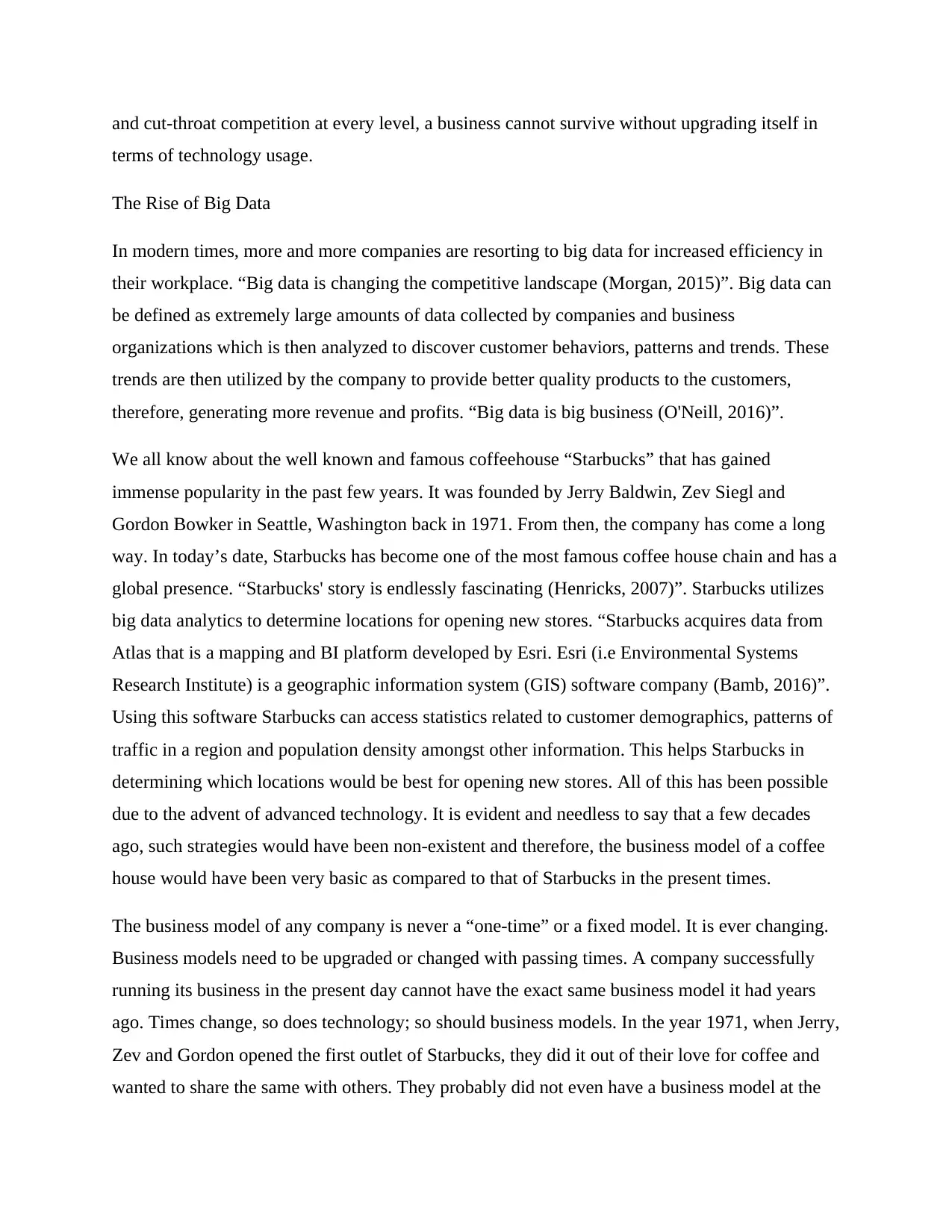
and cut-throat competition at every level, a business cannot survive without upgrading itself in
terms of technology usage.
The Rise of Big Data
In modern times, more and more companies are resorting to big data for increased efficiency in
their workplace. “Big data is changing the competitive landscape (Morgan, 2015)”. Big data can
be defined as extremely large amounts of data collected by companies and business
organizations which is then analyzed to discover customer behaviors, patterns and trends. These
trends are then utilized by the company to provide better quality products to the customers,
therefore, generating more revenue and profits. “Big data is big business (O'Neill, 2016)”.
We all know about the well known and famous coffeehouse “Starbucks” that has gained
immense popularity in the past few years. It was founded by Jerry Baldwin, Zev Siegl and
Gordon Bowker in Seattle, Washington back in 1971. From then, the company has come a long
way. In today’s date, Starbucks has become one of the most famous coffee house chain and has a
global presence. “Starbucks' story is endlessly fascinating (Henricks, 2007)”. Starbucks utilizes
big data analytics to determine locations for opening new stores. “Starbucks acquires data from
Atlas that is a mapping and BI platform developed by Esri. Esri (i.e Environmental Systems
Research Institute) is a geographic information system (GIS) software company (Bamb, 2016)”.
Using this software Starbucks can access statistics related to customer demographics, patterns of
traffic in a region and population density amongst other information. This helps Starbucks in
determining which locations would be best for opening new stores. All of this has been possible
due to the advent of advanced technology. It is evident and needless to say that a few decades
ago, such strategies would have been non-existent and therefore, the business model of a coffee
house would have been very basic as compared to that of Starbucks in the present times.
The business model of any company is never a “one-time” or a fixed model. It is ever changing.
Business models need to be upgraded or changed with passing times. A company successfully
running its business in the present day cannot have the exact same business model it had years
ago. Times change, so does technology; so should business models. In the year 1971, when Jerry,
Zev and Gordon opened the first outlet of Starbucks, they did it out of their love for coffee and
wanted to share the same with others. They probably did not even have a business model at the
terms of technology usage.
The Rise of Big Data
In modern times, more and more companies are resorting to big data for increased efficiency in
their workplace. “Big data is changing the competitive landscape (Morgan, 2015)”. Big data can
be defined as extremely large amounts of data collected by companies and business
organizations which is then analyzed to discover customer behaviors, patterns and trends. These
trends are then utilized by the company to provide better quality products to the customers,
therefore, generating more revenue and profits. “Big data is big business (O'Neill, 2016)”.
We all know about the well known and famous coffeehouse “Starbucks” that has gained
immense popularity in the past few years. It was founded by Jerry Baldwin, Zev Siegl and
Gordon Bowker in Seattle, Washington back in 1971. From then, the company has come a long
way. In today’s date, Starbucks has become one of the most famous coffee house chain and has a
global presence. “Starbucks' story is endlessly fascinating (Henricks, 2007)”. Starbucks utilizes
big data analytics to determine locations for opening new stores. “Starbucks acquires data from
Atlas that is a mapping and BI platform developed by Esri. Esri (i.e Environmental Systems
Research Institute) is a geographic information system (GIS) software company (Bamb, 2016)”.
Using this software Starbucks can access statistics related to customer demographics, patterns of
traffic in a region and population density amongst other information. This helps Starbucks in
determining which locations would be best for opening new stores. All of this has been possible
due to the advent of advanced technology. It is evident and needless to say that a few decades
ago, such strategies would have been non-existent and therefore, the business model of a coffee
house would have been very basic as compared to that of Starbucks in the present times.
The business model of any company is never a “one-time” or a fixed model. It is ever changing.
Business models need to be upgraded or changed with passing times. A company successfully
running its business in the present day cannot have the exact same business model it had years
ago. Times change, so does technology; so should business models. In the year 1971, when Jerry,
Zev and Gordon opened the first outlet of Starbucks, they did it out of their love for coffee and
wanted to share the same with others. They probably did not even have a business model at the
Paraphrase This Document
Need a fresh take? Get an instant paraphrase of this document with our AI Paraphraser
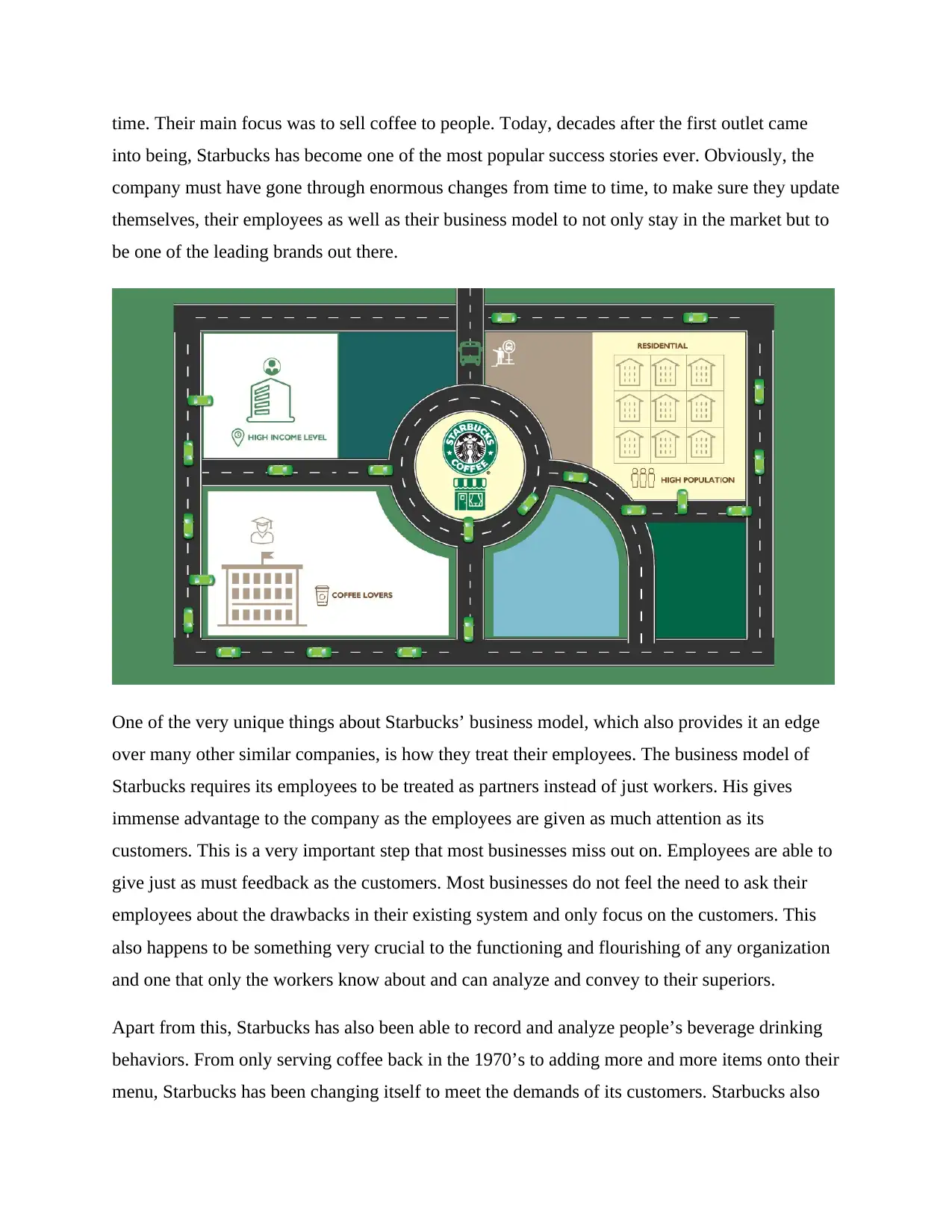
time. Their main focus was to sell coffee to people. Today, decades after the first outlet came
into being, Starbucks has become one of the most popular success stories ever. Obviously, the
company must have gone through enormous changes from time to time, to make sure they update
themselves, their employees as well as their business model to not only stay in the market but to
be one of the leading brands out there.
One of the very unique things about Starbucks’ business model, which also provides it an edge
over many other similar companies, is how they treat their employees. The business model of
Starbucks requires its employees to be treated as partners instead of just workers. His gives
immense advantage to the company as the employees are given as much attention as its
customers. This is a very important step that most businesses miss out on. Employees are able to
give just as must feedback as the customers. Most businesses do not feel the need to ask their
employees about the drawbacks in their existing system and only focus on the customers. This
also happens to be something very crucial to the functioning and flourishing of any organization
and one that only the workers know about and can analyze and convey to their superiors.
Apart from this, Starbucks has also been able to record and analyze people’s beverage drinking
behaviors. From only serving coffee back in the 1970’s to adding more and more items onto their
menu, Starbucks has been changing itself to meet the demands of its customers. Starbucks also
into being, Starbucks has become one of the most popular success stories ever. Obviously, the
company must have gone through enormous changes from time to time, to make sure they update
themselves, their employees as well as their business model to not only stay in the market but to
be one of the leading brands out there.
One of the very unique things about Starbucks’ business model, which also provides it an edge
over many other similar companies, is how they treat their employees. The business model of
Starbucks requires its employees to be treated as partners instead of just workers. His gives
immense advantage to the company as the employees are given as much attention as its
customers. This is a very important step that most businesses miss out on. Employees are able to
give just as must feedback as the customers. Most businesses do not feel the need to ask their
employees about the drawbacks in their existing system and only focus on the customers. This
also happens to be something very crucial to the functioning and flourishing of any organization
and one that only the workers know about and can analyze and convey to their superiors.
Apart from this, Starbucks has also been able to record and analyze people’s beverage drinking
behaviors. From only serving coffee back in the 1970’s to adding more and more items onto their
menu, Starbucks has been changing itself to meet the demands of its customers. Starbucks also
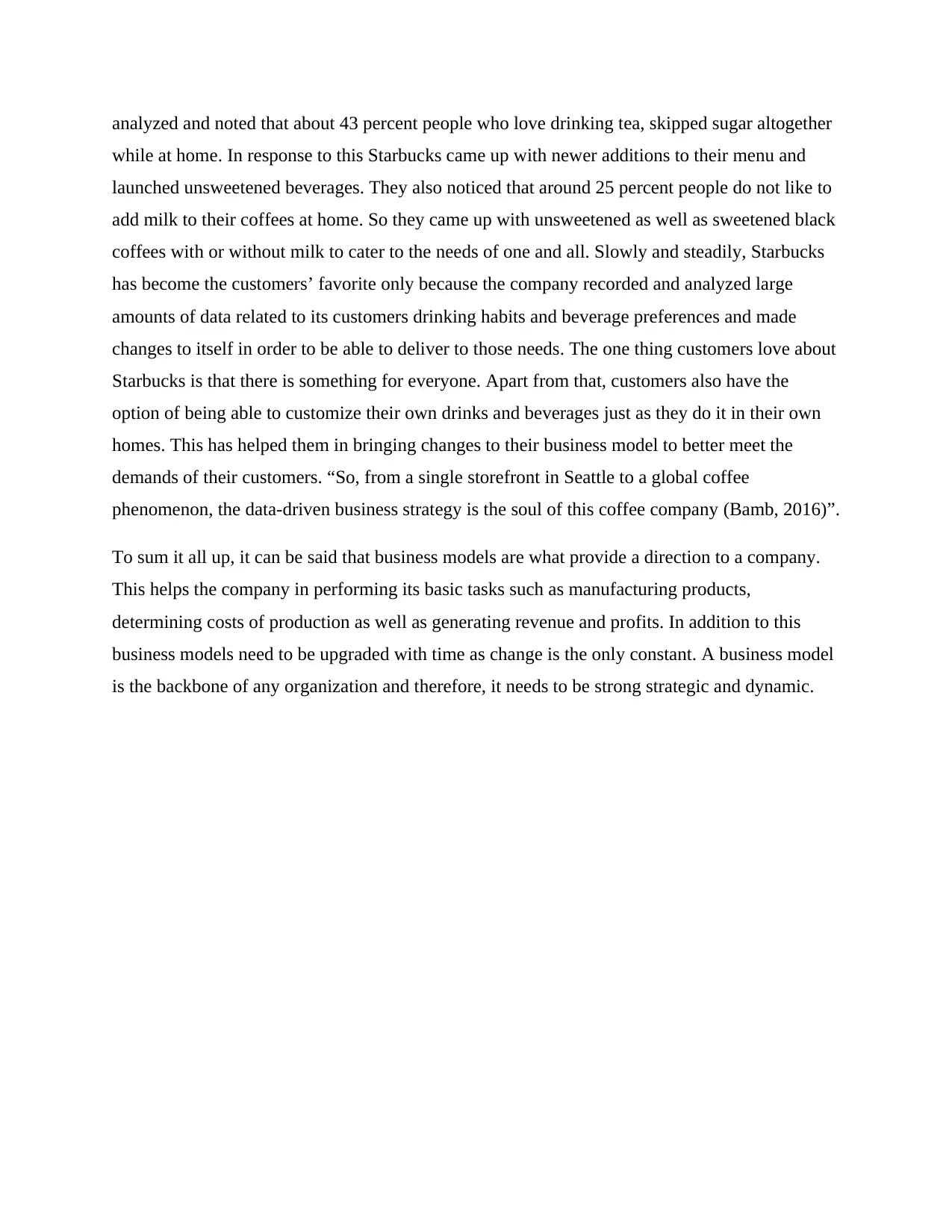
analyzed and noted that about 43 percent people who love drinking tea, skipped sugar altogether
while at home. In response to this Starbucks came up with newer additions to their menu and
launched unsweetened beverages. They also noticed that around 25 percent people do not like to
add milk to their coffees at home. So they came up with unsweetened as well as sweetened black
coffees with or without milk to cater to the needs of one and all. Slowly and steadily, Starbucks
has become the customers’ favorite only because the company recorded and analyzed large
amounts of data related to its customers drinking habits and beverage preferences and made
changes to itself in order to be able to deliver to those needs. The one thing customers love about
Starbucks is that there is something for everyone. Apart from that, customers also have the
option of being able to customize their own drinks and beverages just as they do it in their own
homes. This has helped them in bringing changes to their business model to better meet the
demands of their customers. “So, from a single storefront in Seattle to a global coffee
phenomenon, the data-driven business strategy is the soul of this coffee company (Bamb, 2016)”.
To sum it all up, it can be said that business models are what provide a direction to a company.
This helps the company in performing its basic tasks such as manufacturing products,
determining costs of production as well as generating revenue and profits. In addition to this
business models need to be upgraded with time as change is the only constant. A business model
is the backbone of any organization and therefore, it needs to be strong strategic and dynamic.
while at home. In response to this Starbucks came up with newer additions to their menu and
launched unsweetened beverages. They also noticed that around 25 percent people do not like to
add milk to their coffees at home. So they came up with unsweetened as well as sweetened black
coffees with or without milk to cater to the needs of one and all. Slowly and steadily, Starbucks
has become the customers’ favorite only because the company recorded and analyzed large
amounts of data related to its customers drinking habits and beverage preferences and made
changes to itself in order to be able to deliver to those needs. The one thing customers love about
Starbucks is that there is something for everyone. Apart from that, customers also have the
option of being able to customize their own drinks and beverages just as they do it in their own
homes. This has helped them in bringing changes to their business model to better meet the
demands of their customers. “So, from a single storefront in Seattle to a global coffee
phenomenon, the data-driven business strategy is the soul of this coffee company (Bamb, 2016)”.
To sum it all up, it can be said that business models are what provide a direction to a company.
This helps the company in performing its basic tasks such as manufacturing products,
determining costs of production as well as generating revenue and profits. In addition to this
business models need to be upgraded with time as change is the only constant. A business model
is the backbone of any organization and therefore, it needs to be strong strategic and dynamic.
⊘ This is a preview!⊘
Do you want full access?
Subscribe today to unlock all pages.

Trusted by 1+ million students worldwide
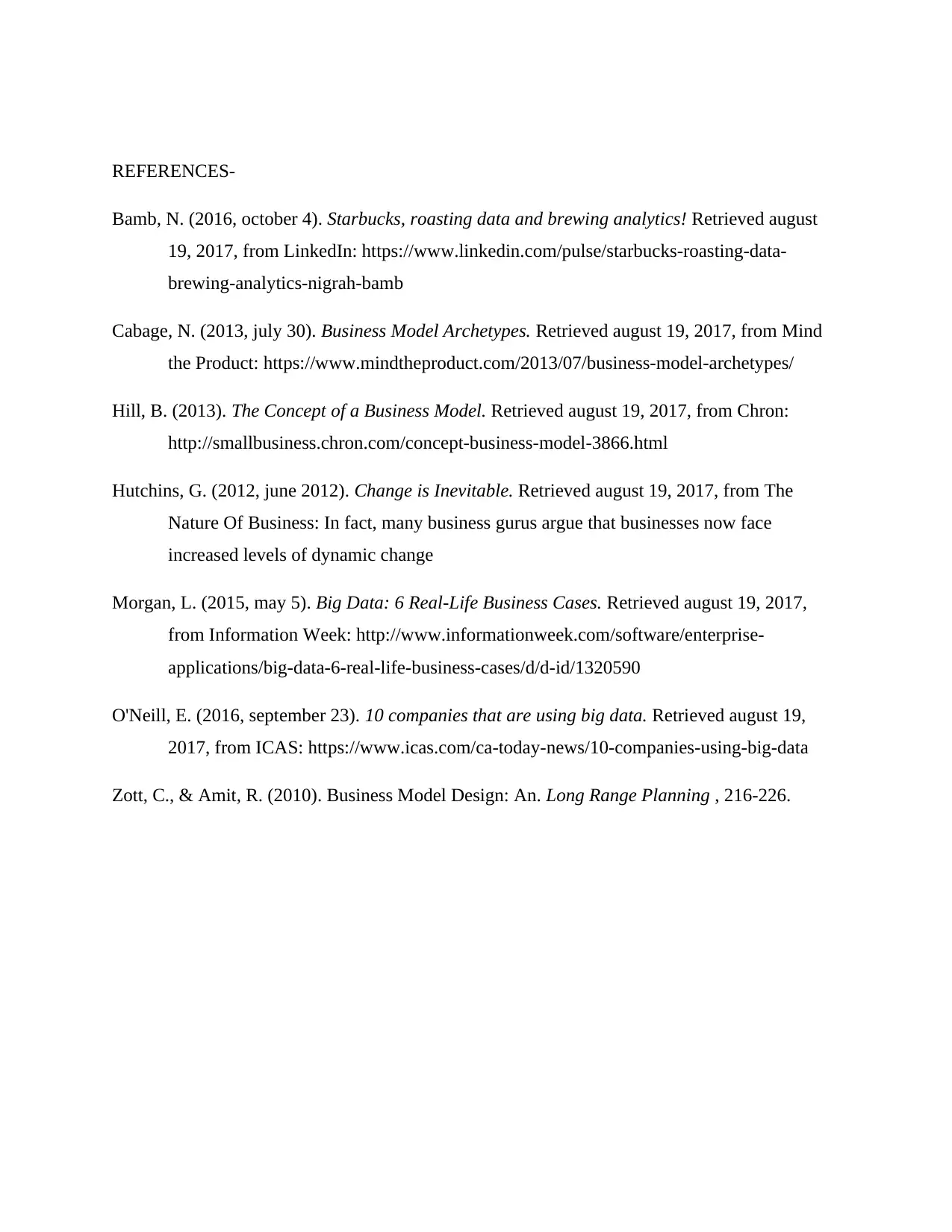
REFERENCES-
Bamb, N. (2016, october 4). Starbucks, roasting data and brewing analytics! Retrieved august
19, 2017, from LinkedIn: https://www.linkedin.com/pulse/starbucks-roasting-data-
brewing-analytics-nigrah-bamb
Cabage, N. (2013, july 30). Business Model Archetypes. Retrieved august 19, 2017, from Mind
the Product: https://www.mindtheproduct.com/2013/07/business-model-archetypes/
Hill, B. (2013). The Concept of a Business Model. Retrieved august 19, 2017, from Chron:
http://smallbusiness.chron.com/concept-business-model-3866.html
Hutchins, G. (2012, june 2012). Change is Inevitable. Retrieved august 19, 2017, from The
Nature Of Business: In fact, many business gurus argue that businesses now face
increased levels of dynamic change
Morgan, L. (2015, may 5). Big Data: 6 Real-Life Business Cases. Retrieved august 19, 2017,
from Information Week: http://www.informationweek.com/software/enterprise-
applications/big-data-6-real-life-business-cases/d/d-id/1320590
O'Neill, E. (2016, september 23). 10 companies that are using big data. Retrieved august 19,
2017, from ICAS: https://www.icas.com/ca-today-news/10-companies-using-big-data
Zott, C., & Amit, R. (2010). Business Model Design: An. Long Range Planning , 216-226.
Bamb, N. (2016, october 4). Starbucks, roasting data and brewing analytics! Retrieved august
19, 2017, from LinkedIn: https://www.linkedin.com/pulse/starbucks-roasting-data-
brewing-analytics-nigrah-bamb
Cabage, N. (2013, july 30). Business Model Archetypes. Retrieved august 19, 2017, from Mind
the Product: https://www.mindtheproduct.com/2013/07/business-model-archetypes/
Hill, B. (2013). The Concept of a Business Model. Retrieved august 19, 2017, from Chron:
http://smallbusiness.chron.com/concept-business-model-3866.html
Hutchins, G. (2012, june 2012). Change is Inevitable. Retrieved august 19, 2017, from The
Nature Of Business: In fact, many business gurus argue that businesses now face
increased levels of dynamic change
Morgan, L. (2015, may 5). Big Data: 6 Real-Life Business Cases. Retrieved august 19, 2017,
from Information Week: http://www.informationweek.com/software/enterprise-
applications/big-data-6-real-life-business-cases/d/d-id/1320590
O'Neill, E. (2016, september 23). 10 companies that are using big data. Retrieved august 19,
2017, from ICAS: https://www.icas.com/ca-today-news/10-companies-using-big-data
Zott, C., & Amit, R. (2010). Business Model Design: An. Long Range Planning , 216-226.
1 out of 7
Related Documents
Your All-in-One AI-Powered Toolkit for Academic Success.
+13062052269
info@desklib.com
Available 24*7 on WhatsApp / Email
![[object Object]](/_next/static/media/star-bottom.7253800d.svg)
Unlock your academic potential
Copyright © 2020–2025 A2Z Services. All Rights Reserved. Developed and managed by ZUCOL.





